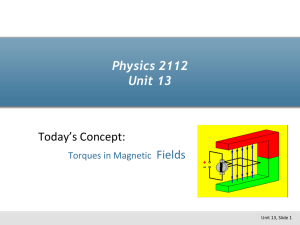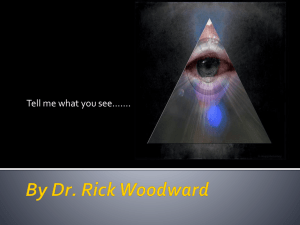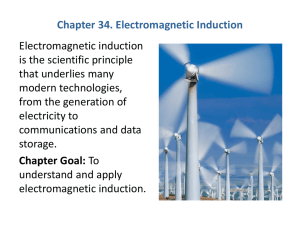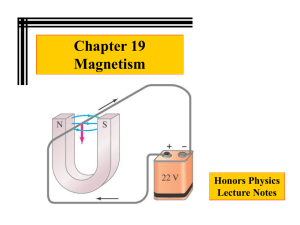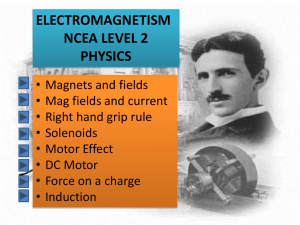Magnetism - Derry Area School District
advertisement
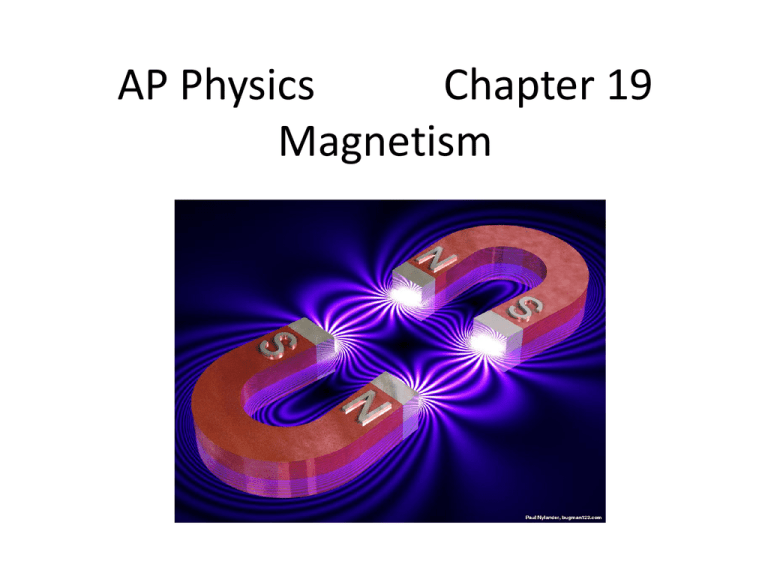
AP Physics Chapter 19 Magnetism Chapter 19: Magnetism 19.1 Magnets, Magnetic Poles, and Magnetic Field Direction 19.2 Magnetic Field Strength and Magnetic Force 19.3 Electromagnetism – The Source of Magnetic Fields 19.4 Omitted 19.5 Magnetic Forces on Current-Carrying Wires 19.6 Applications of Electromagnetism 19.7 Omitted Homework for Chapter 19 • Read Chapter 19 • HW 19.A: p.626-627: 6,9-13,15,24,25,28,29. • HW 19.B: p.629-631:52-56,58,61,62,75,76,78,79. 19.1 Magnets, Magnetic Poles, and Magnetic Field Direction static cling bar magnet electromagnet electric generator pole–force law or law of poles - like magnetic poles repel each other, and unlike magnetic poles attract each other. • The north pole of a compass is the north-seeking end . dipole - poles always occur in pairs, never singly (monopole). If you break a magnet in half, you end up with two smaller dipole magnets. magnetic field (B) - The direction of a magnetic field (or B field) at any location is the direction that the north pole of a compass at that location would point. • Magnetic field lines always point from north to south . • Magnetism and electricity are two aspects of a fundamental force, the electromagnetic force . 19.2 Magnetic Field Strength and Magnetic Force • A magnetic field can exert forces only on moving charges. • When a charged particle enters a magnetic field, the particle experiences a force that is evident because the charge is deflected from its original path. • The electron beam in a cathode ray tube (made visible by fluorescent paper) is normally horizontal between the end electrodes but is deflected here because of the magnet. • We will use the convention: X X X X X X X X is into the page and ● ● ● ● ● ● ● ● is out of the page. On Gold Sheet Right Hand Force Rule: For a positively charged particle the force is in the direction your palm is facing; for a negatively charged particle, the force is in the direction of the back of your hand. Example 19.1: An electron moves with a speed of 4.0 x 106 m/s along the +x-axis. It enters a region where there is a uniform magnetic field of 2.5 T, directed at an angle of 60° to the x axis and lying in the xy plane. Calculate the initial force and acceleration of the electron. A larger mass will have a larger radius. Fc = mac qvB = mv2 r Example 19.2: A proton has a speed of 4.5 x 106 m/s in a direction perpendicular to a uniform magnetic field, and the proton moves in a circle of radius 0.20 m. What is the magnitude of the magnetic field? Check for Understanding 1. When the ends of two bar magnets are near each other, they attract one another. The ends must be a) b) c) d) e) one north, the other south one south, the other north both north both south either a or b Answer: e 2. If you look directly down on the S pole of a bar magnet, the magnetic field points a) to the right b) to the left c) away from you d) toward you Answer: c Check for Understanding 3. A proton moves vertically upward in a uniform magnetic field and deflects to the right as you watch it. What is the magnetic field direction? a) b) c) d) directly away from you directly toward you to the right to the left Answer: b, according to the right hand rule Check for Understanding Check for Understanding 19.3 Electromagnetism – The Source of Magnetic Fields Although a bit unlikely, the idea is that by jarring the domains in the presence of the earth’s magnetic field, they will align with it. On Gold Sheet Right-Hand Source Rule: If a currentcarrying wire is grasped with the right hand with the extended thumb pointing in the direction of the current (I), the curled fingers indicate the circular sense of the magnetic field direction. ● Since magnetic field is a vector, you must use vector addition to find the net field if there are contributions from two or more sources. Example 19.3: What current is required for a long straight wire to produce a magnetic field of magnitude equal to the strength of the Earth’s magnetic field of about 5.0 x 10-5 T at a location 2.5 cm from the wire? Example 19.5: Two long parallel wires carry currents of 20 A and 5.0 A in opposite directions. The wires are separated by 0.20 m. a) What is the magnetic field midway between the two wires? b) At what point between the wires are the magnetic fields from the two wires the same? Check for Understanding 1. A long, straight wire is parallel to the ground and carries a steady current to the east. At a point directly below the wire, what is the direction of the magnetic field the wire produces? a) b) c) d) north east south west Answer: a, according to the right hand source rule. 2. A long, straight current-carrying wire is oriented vertically. On its east side, the field it creates points south. What is the current direction? a) up b) down Answer: b, according to the right hand source rule. Homework for Chapter 19 • HW 19.A: p.626-627: 6,9-13,15,24,25,28,29. 19.5 Magnetic Forces on Current-Carrying Wires no current in the wire X X X On Gold Sheet a) Use the right hand force rule to determine the direction of force. Point the thumb in the direction of the conventional current I and the fingers in the direction of the B-field. The force F is the direction of the palm. b) Here the current is flowing in the opposite direction. Point the thumb in the direction of the current I and the fingers in the direction of B. F is the direction of the palm. • Forces exist between two parallel current-carrying wires. This is because the magnetic field produced by the current in one wire exerts a force on the other wire. • If the currents are in the same direction, the forces attract. If the currents are in opposite directions, the forces repel. Use the right hand rule for Example 19.6: A wire carries a current of 6.0 A in a direction 60° with respect to the direction of a magnetic field of 0.75 T. Find the magnitude of the magnetic force on a 0.50 length of the wire. Torque on a Current-Carrying Loop • A magnetic field can exert torque on a current-carrying loop. • Suppose that the loop in figure a is free to rotate about an axis passing through opposite sides. There are no net forces or torques on the pivot sides of the loop. When these sides are parallel to the B field, the force on them is zero. At any other angle to the field, the forces on them are equal and opposite in the plane of the loop and so produce no net force or net torque. • The other two sides of the loop do produce a net torque, which tends to rotate the loop. Torque on a Current Carrying Coil = NIAB sin Where (not on gold sheet) is the torque N is the number of loops in the coil I is the current A is the area of the loop. It can be any shape. B is the magnetic field is the angle between the normal to the plane of the loop and the B-field. Example 19.7: A circular loop of wire radius 0.50 m is in a uniform magnetic field of 0.30 T. The current in the loop is 2.0 A. Find the magnitude of the torque when a) the plane of the loop is parallel to the magnetic field, b) the plane of the loop is perpendicular to the magnetic field, c) the plane of the loop is at 30° to the magnetic field. Example 19.8: Two long, straight wires separated by a distance of 0.30 m carry currents in the same direction. If the current in one wire is 10 A and the current in the other 8.0 A, find the magnitude and direction of the forces per unit length (per meter) between the wires. What if the currents are in opposite directions? Check for Understanding 1. A long, straight, horizontal wire is located on the equator and carries a current directed toward the east. What is the direction of the force on it due to the Earth’s magnetic field? a) b) c) d) east west south upward Answer: d, according to the right hand force rule Check for Understanding Check for Understanding 19.6 Applications of Electromagnetism electron is not moving no current in the wire X X The dc Motor • An electrical motor is a device that converts electrical energy into mechanical energy. • A pivoted, current carrying coil with N loops in a magnetic field will rotate freely, but for only a half-cycle, or through a maximum angle of 180°. • Recall that = NAIB sin , and when the magnetic field is perpendicular to the plane of the coil (sin = 0), the torque is zero and the coil is in equilibrium. • To provide for continuous rotation, the current is reversed every half turn so that the torque-producing forces are reversed. This is done by means of a split-ring commutator. • Contact brushes provide a path for current. • When current is supplied, one half-ring is electrically positive and the other negative. The coil and ring rotates. • When the coil and ring have gone through half a rotation, the half rings come in contact with the opposite brushes. Their polarity is reversed, and the current in the coil is in the opposite direction. This changes the directions of the torque. The process repeats and the spinning continues. For a real motor, the rotating shaft is called the armature. Cathode Ray Tube (CRT) • The cathode ray tube is a vacuum tube that is used in an oscilloscope, such as those in some laboratories. • Electrons, negatively charged, are “boiled off” a hot filament in an electron gun and accelerated by a voltage applied between the cathode (-) and anode (+). • The picture tube in older television sets and computer monitors is also a cathode ray tube. • Magnetic coils are usually used there to deflect the electron beam. Open this Cathode Ray Tube Simulation in Explorer: http://highered.mcgrawhill.com/olcweb/cgi/pluginpop.cgi?it=swf::100 %::100%::/sites/dl/free/0072512644/117354/ 01_Cathode_Ray_Tube.swf::Cathode Ray Tube The Mass Spectrometer • A mass spectrometer is a device used to measure the mass of atoms or molecules. It is often used to separate isotopes, or atoms of different masses. • Actually, the masses of ions are measured since electric and magnetic fields have motional effects only on charged particles. (An ion is an atom or molecule with a net electric charge.) • Ions with a known charge (+q) are produced by heating the substance to be analyzed. • The resulting beam of ions introduced into the mass spectrometer has a distribution of speeds. Ions with a particular velocity are selected by means of a velocity selector, made up of charged plates and a magnetic field that allow particles traveling at only that velocity to go undeflected. • The values of the E and B fields between the plates of the velocity selector determine the velocity. • For a positively charged ion, the E-field produces a downward force F = qE. The B-field produces an upward force F = qvB1. • If the beam is not deflected, the resultant force must be zero, so qE = qvB1 or v=E B1 • If the plates are parallel, E = V/d. Since the voltage and plate separation are controllable quantities, a more practical version of the equation is v=V ion speed in a velocity selector B1d • Beyond the velocity selector, the beam passes through a slit into another magnetic field (B2), which is perpendicular to the direction of the beam. • The force due to this magnetic field (F = qvB2) is always perpendicular to the velocity of the ions, which are therefore deflected along a circular path. • The magnetic force supplies the centripetal force for this motion, and mv2 = qvB2 r so, m = qdB1B2 V r particle mass via mass spectrometer Example 19.9: In a mass spectrometer, a single-charged particle has a speed of 1.0 x 106 m/s and enters a uniform magnetic field of 0.20 T. The radius of the circular orbit is 0.020 m. a) What is the mass of the particle? b) What is the kinetic energy of the particle? Check for Understanding 1. A mass spectrometer a) b) c) d) can be used to determine the masses of atoms and molecules requires charged particles can be use to determine relative abundances of isotopes all of these Answer: d 2. Why can a nearby magnet distort the display of a computer monitor or television picture tube? Answer: The magnetic force on the electron beam, which “prints” pictures, causes the deflection of the electrons. Homework for Chapter 19 • HW 19.B: p.629-631:52-56,58,61,62,75,76,78,79. Chapter 19 Formulas v= m= E = B1 V B1d qdB1B2 V ion speed in a velocity selector r = qB2r v particle mass via mass spectrometer



